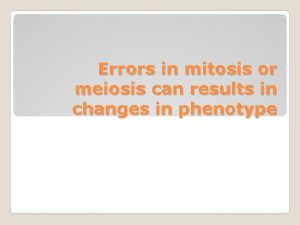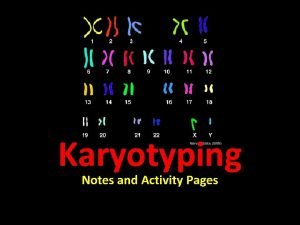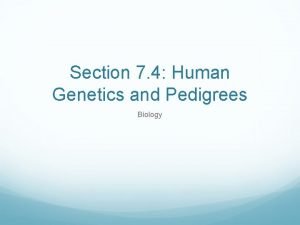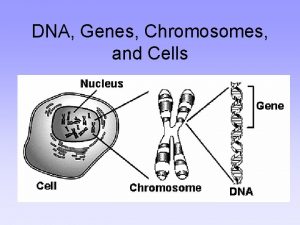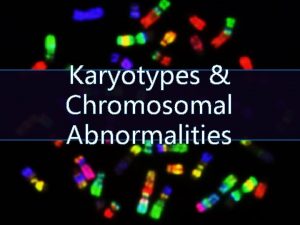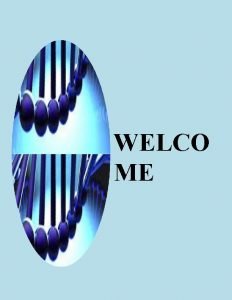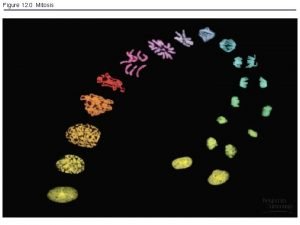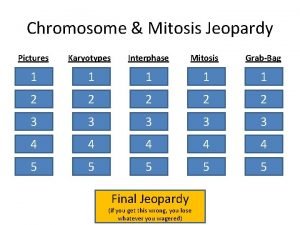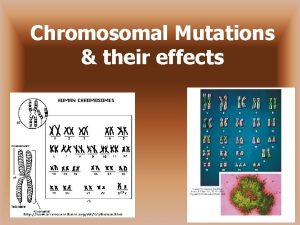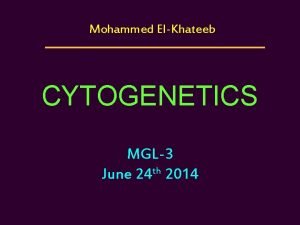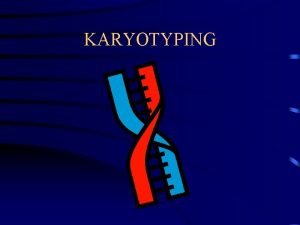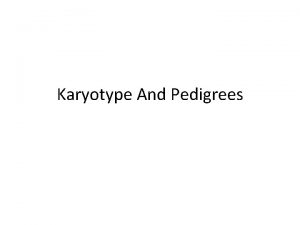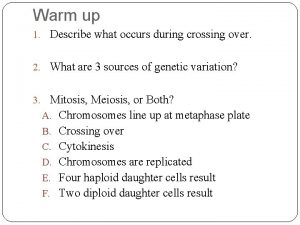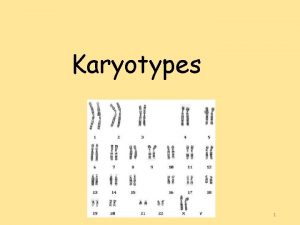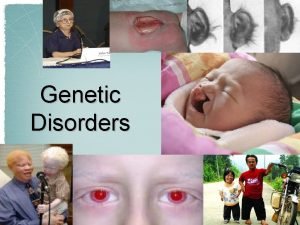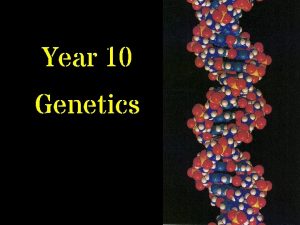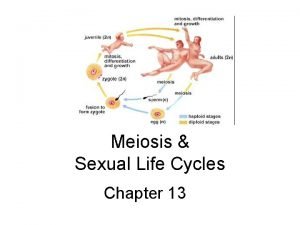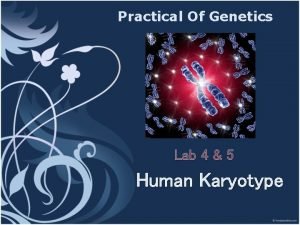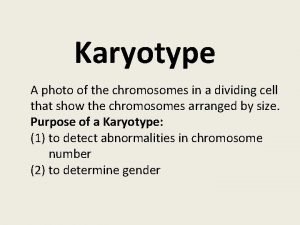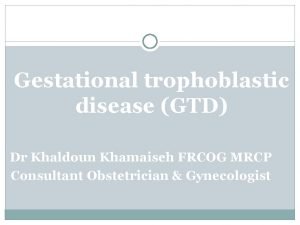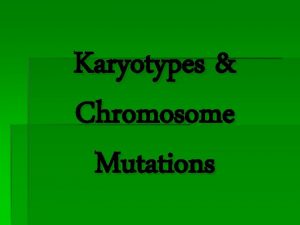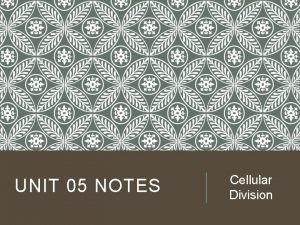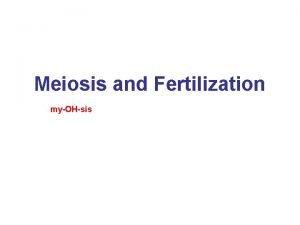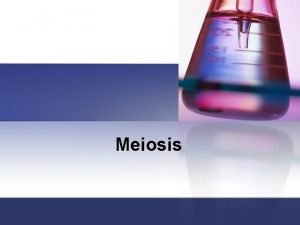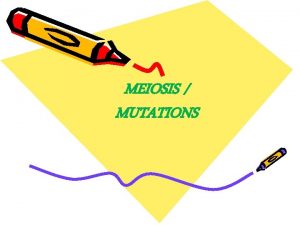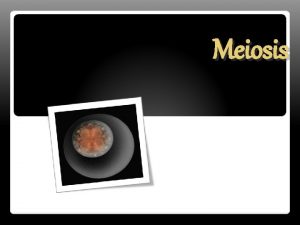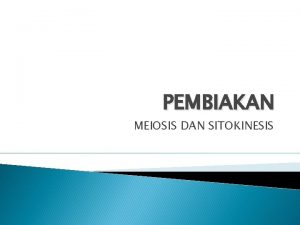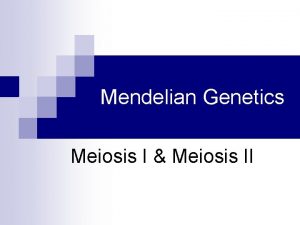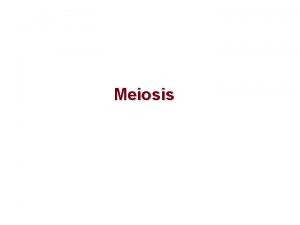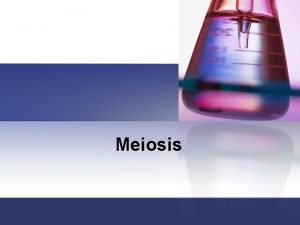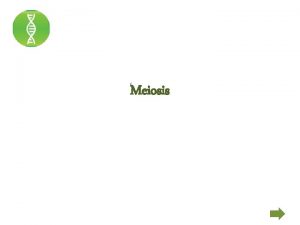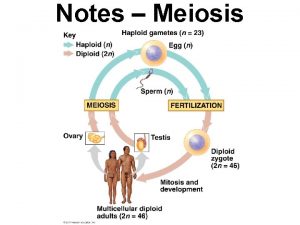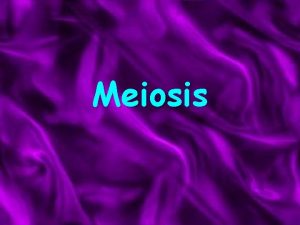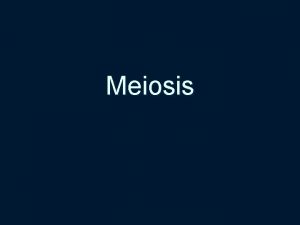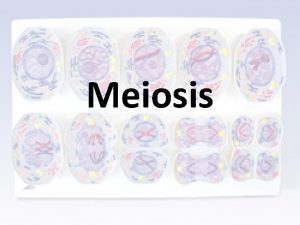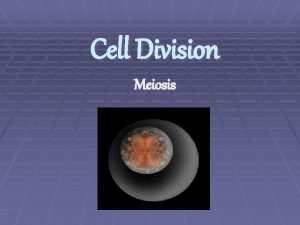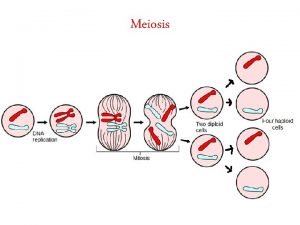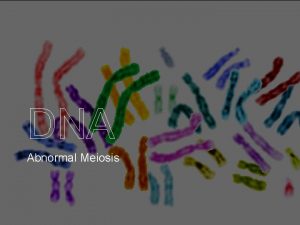Errors in Meiosis Preparing a Karyotype A karyotype






































- Slides: 38

Errors in Meiosis

Preparing a Karyotype • A karyotype is a picture of all the chromosomes in a cell • Karyotopes are made by growing rapidly-dividing cells (eg. skin or blood cells) in a lab • Cell division is arrested in metaphase when the individual chromosomes are most visible • Chromosomes are stained, photographed, and grouped by size and banding patterns

Karyotype • Humans have 23 homologous pairs • Chromosome pairs 1 to 22 are called autosomes • The 23 rd pair are the sex chromosomes. Females have two X chromosomes (XX) and males have an X and a Y (XY).

Errors in Meiosis • Sometimes there is an error in meiosis • Non-disjunction occurs when chromosomes do not separate properly during anaphase I or anaphase II of meiosis • Errors in meiosis are more likely in the eggs of older women


Errors in Meiosis Errors can occur in sperm or eggs. A gamete gets either: • three homologous chromosomes instead of two, causing a trisomy • only one copy of a homologous chromosome instead of two, causing a monosomy • The error in meiosis is passed to the zygote so ALL cells in the body are affected

Syndromes • Each chromosome carries hundreds or thousands of genes • Extra or missing chromosomes affect many genes. They cause a large group of symptoms which is called a syndrome (a group of typical signs and symptoms).

Monosomies A monosomy is a genetic disorder in which there is only one copy of a chromosome, instead of a homologous pair. Almost all monosomies are lethal to the fetus.

Turner’s Syndrome (XO) • Turner’s syndrome is a non-lethal monosomy • The fetus has only one sex chromosome (monosomy XO) • The X can be missing from the sperm or the egg

Turner’s Syndrome • Children with Turner’s syndrome are always female (XO) • They are shorter than average, stocky and have a “webbed” neck • Intelligence is normal • They are infertile

• http: //www. childgrowthfoundation. org/Accordion. aspx? page=Storiesturner • http: //www. doctortipster. com/3328 -turnersyndrome. html

Trisomy If a zygote gets an extra copy of a chromosome from either the egg or the sperm, it is called a trisomy. Most autosomal trisomy (chromosomes 1 – 22) are lethal, but three can survive: • trisomy 21 (Down syndrome) • trisomy 18 (Edwards syndrome) • trisomy 13 (Patau syndrome)

Down Syndrome The zygote has three copies of chromosome 21, often two from the mother

Down Syndrome (Trisomy 21) People with Down Syndrome often have: • Flat face with upward slanted eyes • Short neck • Large tongue which causes feeding and speech problems • Significant cognitive impairment • Poor muscle tone • Small hands and feet

Down Syndrome (Trisomy 21) Common health issues include: • heart problems • respiratory problems • vision and hearing problems • dementia (similar to Alzheimer’s) later in life Overall, Downs Syndrome individuals can lead healthy lives. The average life expectancy is 60 years old.

Down Syndrome

Down Syndrome • http: //www. sheknows. com/parenting/articles/974255/october-is-down-syndrome-awareness-month

Down Syndrome • http: //www. timeanddate. com/holidays/un/down-syndrome-day

Trisomy 18: Edwards Syndrome The zygote has three copies of chromosome 18

Edwards Syndrome (Trisomy 18) Usually lethal to the fetus during pregancy. If the fetus survives, few children live past one year of age. Serious medical problems, including: • Heart defects • Stomach and intestinal defects • Deformed limbs • Severe cognitive impairment

Edwards Syndrome (Trisomy 18) • http: //www. prenatalpartnersforlife. org/Stories/Trisomy 18_Bella. htm

Edwards Syndrome (Trisomy 18) • https: //pedclerk. bsd. uchicago. edu/page/trisomy-18 -edwards-trisomy-13 -patau

Edwards Syndrome (Trisomy 18) • Fraternal twin girls: Emmy (on right) has Edwards syndrome (blue colour due to heart problems). She survived only 15 days. • http: //www. prenatalpartnersforlife. org/Stories/Trisomy 18 Emmy. htm

Patau Syndrome (Trisomy 13) The zygote has three copies of chromosome 13

Patau Syndrome (Trisomy 13) Often lethal to the fetus during pregancy. If the fetus survives, few children live past one year of age. Serious medical problems, including: • Heart defects • Brain malformations and impairment • Cleft palate and a large bulbous nose • Deformed limbs, clenched hands

Patau Syndrome (Trisomy 13) http: //www. trisomy 13 archive. com/albums/album 18. htm

Patau Syndrome (Trisomy 13) • http: //symptomstreatment. org/patau-syndrome/

Patau Syndrome (Trisomy 13) • http: //symptomstreatment. org/patau-syndrome/

Non-disjunction of the Sex Chromosomes Non-disjunction can also occur in the sex chromosomes • These are not usually lethal and often go undiagnosed • All trisomies of the sex chromosomes cause patients to be taller than normal

Klinefelter Syndrome (XXY) Zygote gets two copies of the X chromosome from the mother

Klinefelter Syndrome (XXY) • All patients are male • The extra X chromosome interferes with testosterone production • Men have small testes, usually infertile • Often no facial hair • May show slight breast development • May have cognitive impairment

Klinefelter Syndrome (XXY)

Klinefelter Syndrome (XXY) Untreated

Klinefelter Syndrome (XXY) A different patient after 3 months treatment with testosterone

“Supermale” Syndrome (XYY) Zygote gets chromosome of the Y father two copies from the

“Supermale” Syndrome (XYY) • All patients are male • Most are never diagnosed • Above average height, but otherwise there are no characteristic physical signs • Higher incidence of learning disorders • Was previously believed that these men were more aggressive than normal, but this has been disproven

Triple X Syndrome (XXX) Zygote gets chromosome or father of the X the mother two copies from either

Triple X Syndrome (XXX) • All patients are female • Most are never diagnosed • Above average height, but otherwise there are no characteristic physical signs • Higher incidence of speech disorders • May have slightly smaller heads than normal • Fertility is normal
 Mitosis jeopardy
Mitosis jeopardy Differences between mitosis and meiosis
Differences between mitosis and meiosis Disvantages of sexual reproduction
Disvantages of sexual reproduction Chapter 10 section 1 meiosis worksheet answer key
Chapter 10 section 1 meiosis worksheet answer key Meisis 1 and 2
Meisis 1 and 2 Chapter 10 meiosis 1 and meiosis 2 answer key
Chapter 10 meiosis 1 and meiosis 2 answer key Meiosis and genetic variation answer key
Meiosis and genetic variation answer key Prophase ii meiosis
Prophase ii meiosis Criminal syndrome
Criminal syndrome Karyotype map
Karyotype map Klienfelters syndrome have karyotype
Klienfelters syndrome have karyotype Turner syndrome karyotype
Turner syndrome karyotype Karyotyping
Karyotyping Karyotype of edwards syndrome
Karyotype of edwards syndrome Female karyotype
Female karyotype Karyotype
Karyotype Chromosomal mutation
Chromosomal mutation Spectral karyotype
Spectral karyotype 47 +21
47 +21 Mitosis
Mitosis Karyotyping
Karyotyping Pedigrees and karyotypes
Pedigrees and karyotypes Dog karyotype
Dog karyotype Whats a nondisjunction
Whats a nondisjunction What is reproduction and its types
What is reproduction and its types Aneuploidy
Aneuploidy Whats a nondisjunction
Whats a nondisjunction What are some uses of analyzing karyotypes?
What are some uses of analyzing karyotypes? Punnett square xy
Punnett square xy Karyotype human female
Karyotype human female Learn genetics utah karyotype
Learn genetics utah karyotype Nondisjunction
Nondisjunction Human karyotype practical
Human karyotype practical Trisomy 21
Trisomy 21 Whats a karyotype
Whats a karyotype Figo prognostic scoring system gtn
Figo prognostic scoring system gtn Mutated karyotype
Mutated karyotype 23 chromosome pairs
23 chromosome pairs Whats a karyotype
Whats a karyotype
